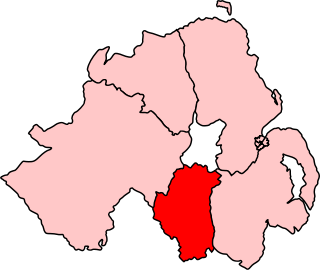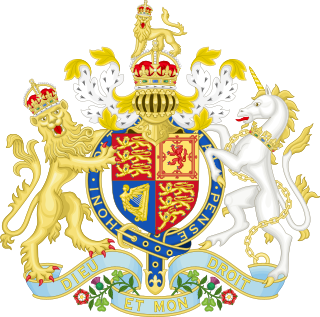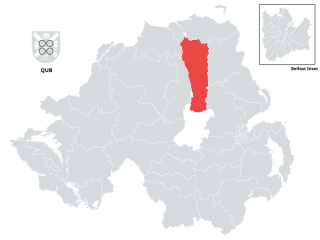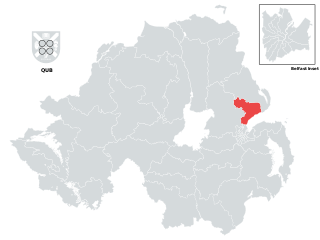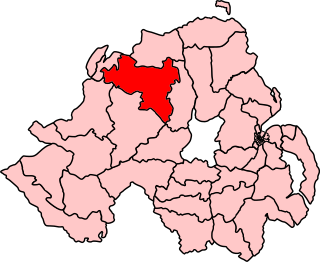| Northern Ireland Parliamentary Constituencies | |
|---|---|
 Map of Northern Ireland's Parliamentary Constituencies from 1929-1969 | |
| Category | Electoral district |
| Location | Northern Ireland |
| Number | 48+4 (from QUB) |
| Government | |
| (1921–72) |
The Northern Ireland House of Commons existed from 1921 to 1973 as the lower House of the devolved legislature of the part of the United Kingdom called Northern Ireland.
Contents
- Historical representation by party
- Antrim
- Belfast
- Down
- Fermanagh and Tyrone
- Londonderry
- Queen's University
As in the UK Parliament the constituencies were classified as borough, county or university constituencies.
In 1921–29 the 52 provincial Members of Parliament were elected using proportional representation by the single transferable vote in multi member constituencies. The constituencies which returned one or two members to the UK Parliament, between 1922 and 1950, were used for Northern Ireland devolved elections in the 1921–29 period.
Between 1929 and 1969 there were 48 single member constituencies, using the first past the post method of election. The non-territorial University constituency continued to return 4 members using the single transferable vote.
For the 1969 election 4 new territorial constituencies were created to replace the University seats. The 52 constituencies ceased to exist after the Parliament of Northern Ireland was suspended in 1972 and abolished in 1973.
| Period | Constituency | Type | Notes |
|---|---|---|---|
| 1921–1929 | Antrim | county | 7 MPs |
| 1929–1973 | Antrim Borough | county | |
| 1929–1973 | Bann Side | county | |
| 1929–1973 | Carrick | county | |
| 1969–1973 | Larkfield | county | |
| 1929–1973 | Larne | county | |
| 1929–1973 | Mid Antrim | county | |
| 1969–1973 | Newtownabbey | county | |
| 1929–1973 | North Antrim | county | |
| 1929–1973 | South Antrim | county | |
| 1921–1929 | Armagh | county | 4 MPs |
| 1929–1973 | Central Armagh | county | |
| 1929–1973 | Mid Armagh | county | |
| 1929–1973 | North Armagh | county | |
| 1929–1973 | South Armagh | county | |
| 1929–1973 | Belfast Ballynafeigh | borough | |
| 1929–1973 | Belfast Bloomfield | borough | |
| 1929–1973 | Belfast Central | borough | |
| 1929–1973 | Belfast Clifton | borough | |
| 1929–1973 | Belfast, Cromac | borough | |
| 1929–1973 | Belfast Dock | borough | |
| 1929–1973 | Belfast Duncairn | borough | |
| 1921–1929 | Belfast East | borough | 4 MPs |
| 1929–1973 | Belfast Falls | borough | |
| 1921–1929 | Belfast North | borough | 4 MPs |
| 1929–1973 | Belfast Oldpark | borough | |
| 1929–1973 | Belfast Pottinger | borough | |
| 1929–1973 | Belfast St Anne's | borough | |
| 1929–1973 | Belfast Shankill | borough | |
| 1921–1929 | Belfast South | borough | 4 MPs |
| 1929–1973 | Belfast Victoria | borough | |
| 1921–1929 | Belfast West | borough | 4 MPs |
| 1929–1973 | Belfast Willowfield | borough | |
| 1929–1973 | Belfast Windsor | borough | |
| 1929–1973 | Belfast Woodvale | borough | |
| 1921–1929 | Down | county | 8 MPs |
| 1929–1973 | Ards | county | |
| 1969–1973 | Bangor | county | |
| 1929–1973 | East Down | county | |
| 1929–1973 | Iveagh | county | |
| 1969–1973 | Lagan Valley | county | |
| 1929–1973 | Mid Down | county | |
| 1929–1973 | Mourne | county | |
| 1929–1973 | North Down | county | |
| 1929–1973 | South Down | county | |
| 1929–1973 | West Down | county | |
| 1921–1929 | Fermanagh and Tyrone | county | 8 MPs |
| 1929–1973 | Enniskillen | county | |
| 1929–1973 | Lisnaskea | county | |
| 1929–1973 | South Fermanagh | county | |
| 1921–1929 | Londonderry | county | 5 MPs |
| 1929–1973 | City of Londonderry | borough | |
| 1929–1973 | Foyle | borough | |
| 1929–1973 | Mid Londonderry | county | |
| 1929–1973 | North Londonderry | county | |
| 1929–1973 | South Londonderry | county | |
| 1921–1969 | Queen's University, Belfast | university | 4 MPs |
| 1929–1973 | East Tyrone | county | |
| 1929–1973 | Mid Tyrone | county | |
| 1929–1973 | North Tyrone | county | |
| 1929–1973 | South Tyrone | county | |
| 1929–1973 | West Tyrone | county |





